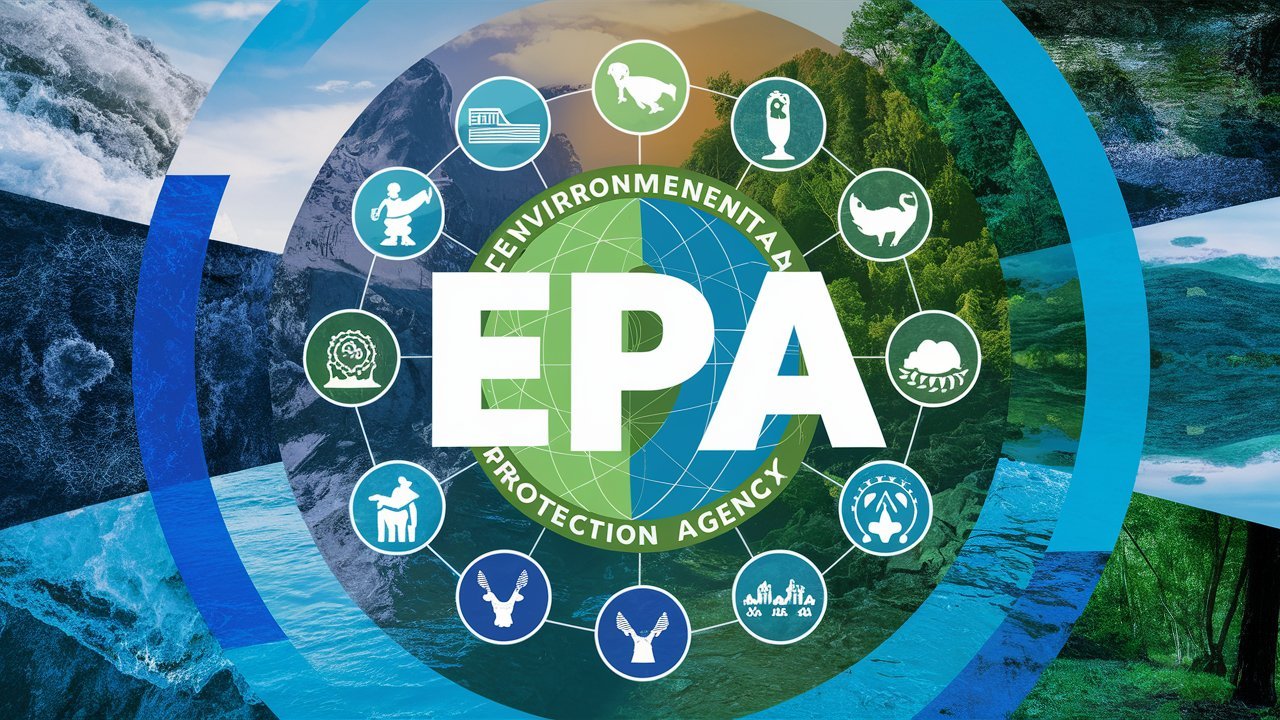Amid the intricate web of environmental management, a stalwart institution stands as a beacon of regulation and protection: the Environmental Protection Agency (EPA). Founded in 1970, the EPA emerged in response to growing concerns over escalating pollution levels affecting air, water, and land across the United States.
Since its inception, the EPA has played a pivotal role in shaping policy frameworks and implementing regulations aimed at safeguarding human health and ecological well-being from harmful environmental practices.
Tasked with a multifaceted mandate that encompasses monitoring, enforcing regulations, and setting national standards for environmental quality, the EPA serves as a linchpin in steering environmental stewardship efforts within the governmental framework.
Over time, this agency has cemented its reputation as an indispensable entity dedicated to upholding both legislative imperatives and public interest concerns regarding ecological sustainability.
As we delve deeper into understanding the intricacies of the EPA’s functioning, we unveil not just an administrative body but a strategic nexus where science converges with policy to chart a path towards sustainability in our ever-evolving ecosystem.
The Environmental Protection Agency (EPA).
The Environmental Protection Agency (EPA) serves as a pivotal entity in safeguarding environmental health and promoting sustainable practices within the United States. Established in 1970 by President Richard Nixon, the EPA operates under the premise of protecting human health and the environment through comprehensive regulatory oversight.
The EPA’s purview extends across a wide array of environmental concerns, encompassing air and water quality standards, waste management protocols, pesticide usage regulations, and toxic substance control. By defining these responsibilities clearly, the EPA sets a foundation for ensuring that environmental protection remains a national priority.
An essential function of the EPA lies in setting stringent environmental standards that govern various industries’ operations to reduce pollutants and mitigate ecological harm. These standards act as benchmarks for businesses to adhere to, ensuring that their activities do not pose threats to public health or natural ecosystems.
Furthermore, the agency plays a critical role in enforcing these regulations through monitoring, inspections, and punitive measures against non-compliant actors. For instance, the Clean Air Act implemented by the EPA not only establishes emission limits for industrial facilities but also mandates periodic audits to verify compliance and penalizes violators accordingly.
Collaboration forms an integral part of the EPA’s strategy towards effective environmental management. By partnering with state agencies, local governments, tribal nations, and even international bodies where necessary, the EPA leverages a collective approach to address pressing environmental challenges that transcend geographical boundaries.
An illuminative instance is the partnership between the EPA and the Department of Energy in promoting energy efficiency programs nationwide. Through shared resources and expertise exchange, such collaborative efforts enhance information sharing, streamline regulatory enforcement processes, and foster innovative solutions to complex environmental problems at both regional and global scales.
EPA Regulations and Policies.
The Environmental Protection Agency (EPA) plays a crucial role in safeguarding the environment through a robust framework of regulations. Notable among these regulations is the Clean Air Act, enacted in 1970, which empowers the EPA to set national air quality standards for pollutants like carbon monoxide, lead, nitrogen dioxide, ozone, particulate matter, and sulfur dioxide.
Under this Act, the EPA has successfully reduced emissions of harmful pollutants from vehicles, industries, and power plants, significantly improving air quality across the country.
The phased implementation of programs like the Acid Rain Program and the Cross-State Air Pollution Rule exemplifies how the EPA utilizes scientific research to establish regulations that have tangible positive impacts on public health and the environment.
In addition to air quality initiatives, landmark policies such as the Clean Water Act have been instrumental in protecting water resources. By establishing pollution control programs and regulating discharge permits for industries and wastewater treatment plants, the EPA ensures that water bodies are safe for drinking, swimming, and aquatic life.
Through rigorous monitoring efforts and enforcement actions against violators, the agency upholds these standards effectively. The development of Total Maximum Daily Loads (TMDLs) for impaired water bodies demonstrates the technical detail involved in formulating policies aimed at restoring water quality to acceptable levels.
Analyzing the process by which new regulations are developed highlights a meticulous approach employed by the EPA. This involves extensive research, stakeholder consultations, risk assessments, cost-benefit analyses, public comment periods, and adherence to legal procedures outlined in environmental statutes.
For instance, when establishing limits on mercury emissions from coal-fired power plants through the Mercury Air Toxics Standards (MATS), the EPA conducted thorough studies to assess health risks associated with mercury exposure and engaged with industry representatives to evaluate compliance challenges.
By incorporating input from diverse stakeholders while prioritizing environmental protection goals backed by scientific evidence, the EPA ensures that its regulatory measures are soundly crafted and effective in achieving their intended outcomes.
Impact of EPA Initiatives.
The Environmental Protection Agency (EPA) has been instrumental in spearheading efforts to ensure environmental protection through various initiatives that have yielded positive outcomes. For instance, the Clean Air Act Amendments of 1990, enforced by the EPA, significantly reduced air pollution levels nationwide.
By targeting pollutants like sulfur dioxide and nitrogen oxides, the regulations led to improved air quality, resulting in reduced cases of respiratory illnesses and associated healthcare costs. Additionally, the phasing out of leaded gasoline demonstrated a tangible success in reducing lead exposure among the population, especially children, contributing to enhanced public health.
Evaluating the economic impacts of EPA regulations reveals a nuanced perspective. While critics often cite potential economic burdens from compliance costs, studies indicate substantial societal benefits.
For example, the implementation of strict regulations on wastewater discharges has proven to save billions annually in health-related expenses and environmental remediation costs. Furthermore, investments in green technologies spurred by EPA guidelines have fostered innovation and job creation in sectors such as renewable energy and clean transportation systems.
Despite its notable achievements, the EPA faces criticisms and challenges in executing its mandates effectively. One recurring concern is the balance between environmental protection and economic growth. Striking a harmonious equilibrium between stringent regulations for ecological preservation and facilitating industrial development remains a contentious issue.
Moreover, administrative changes and budget constraints can impede agency operations, potentially hindering the robust enforcement of environmental regulations. Addressing these challenges requires strategic planning and stakeholder engagement to enhance regulatory efficacy while fostering sustainable growth practices across industries.
Innovations and technological advancements are playing a pivotal role in improving environmental monitoring and compliance efforts. The EPA utilizes state-of-the-art technologies such as remote sensing, geographic information systems (GIS), and real-time monitoring tools to track air and water quality, detect pollution sources, and assess environmental risks.
These advanced monitoring systems enable the EPA to collect accurate data on pollution levels, promptly identify non-compliance with regulations, and take swift action to mitigate environmental threats. By leveraging technology, the EPA can enhance transparency, efficiency, and effectiveness in enforcing environmental laws.
One noteworthy initiative by the EPA is the adoption of smart waste management techniques to promote sustainability. Through programs like the Food Recovery Challenge, the EPA encourages businesses and organizations to reduce food waste through innovative practices such as composting, donation of excess food to charities, and source reduction strategies.
By incorporating cutting-edge waste management technologies like anaerobic digesters and bioconversion processes, the EPA aims to minimize landfill waste while generating renewable energy or valuable byproducts from organic materials. These sustainable waste management approaches not only support conservation efforts but also contribute to reducing greenhouse gas emissions.
Looking ahead, emerging technologies hold immense potential to revolutionize environmental management practices. Innovations such as artificial intelligence (AI) for predictive modeling of environmental impacts, blockchain technology for transparent tracking of supply chains’ sustainability credentials, and drones for rapid assessment of ecological damage following natural disasters are poised to reshape how environmental challenges are addressed.
As these technologies mature and become more widely adopted, the EPA’s ability to proactively protect ecosystems, respond to emergencies swiftly, and foster sustainable development will be significantly enhanced. Embracing these advancements is crucial for staying at the forefront of environmental stewardship in an increasingly complex world marked by rapid industrialization and climate change impacts.
Role of Stakeholders in Supporting EPA’s Mission.
Stakeholders play a vital role in either advancing or impeding the objectives of the Environmental Protection Agency (EPA). Industry stakeholders, for instance, can either contribute to environmental degradation through practices like excessive pollution or support EPA’s goals by investing in sustainable technologies.
By complying with EPA regulations and actively engaging in environmentally friendly practices, industries can significantly impact the overall success of environmental management. This collaboration ensures that industrial activities are conducted in a manner that minimizes their ecological footprint.
Communities also serve as crucial partners to the EPA, representing grassroots movements that advocate for cleaner environments and hold polluting entities accountable. When communities actively participate in reporting environmental violations or providing valuable data to support EPA initiatives, it strengthens the agency’s ability to enforce regulations effectively.
In instances where community members are engaged in monitoring local water quality or air pollution levels, they become integral allies in safeguarding environmental health.
Moreover, academia plays a pivotal role in supporting EPA’s mission through research collaborations, data analysis, and educational initiatives. Universities and research institutions offer valuable expertise in developing scientific methodologies for environmental assessments and regulatory frameworks.
By partnering with academia, the EPA gains access to cutting-edge research insights that inform policy decisions and enhance environmental protection efforts substantially. For example, collaborative studies on the impact of pollutants on ecosystems have led to more stringent regulations concerning harmful substances, illustrating how academic partnerships can drive positive change in environmental management.
In practice, successful outcomes have been achieved through collaborative efforts between stakeholders and the EPA. For instance, joint projects involving industry leaders, community representatives, and academic experts have resulted in innovative solutions for waste management or pollution control.
These multidisciplinary approaches not only address immediate environmental concerns but pave the way for sustainable practices that benefit all parties involved. By fostering cooperation among diverse stakeholders who share a common interest in preserving the environment, the EPA can leverage collective expertise and resources to advance its mission effectively.
Future Outlook and Challenges Facing Environmental Management.
As we look towards the future of environmental management, it is essential to anticipate the potential trends that will shape upcoming environmental policies under new administrations. With the increasing awareness of global challenges like climate change, there is a growing need for robust strategies and regulations to address these pressing issues effectively.
The Environmental Protection Agency (EPA) will play a crucial role in navigating these challenges by collaborating with stakeholders to develop innovative solutions and ensure sustainable environmental practices.
To support stronger collaboration with agencies like the EPA in addressing upcoming challenges, stakeholders should focus on fostering partnerships that promote information sharing, technical expertise exchange, and joint initiatives. Industry leaders can contribute by implementing environmentally friendly practices, while communities can engage in conservation efforts to support the EPA’s mission.
Academia also plays a vital role through research and innovation that can inform evidence-based policy decisions. By working together towards common goals, stakeholders can enhance the impact of environmental management initiatives and create a more sustainable future for generations to come.
In conclusion, as we face complex environmental challenges ahead, it is imperative for all stakeholders to unite in their commitment to environmental protection and sustainability.
By aligning efforts, leveraging expertise from diverse sectors, and advocating for rigorous policies guided by scientific evidence, we can empower agencies like the EPA to lead transformative changes that safeguard our environment for years to come.
Together, we have the opportunity to shape a future where environmental management is not just a regulatory obligation but a shared value ingrained in every aspect of society.



